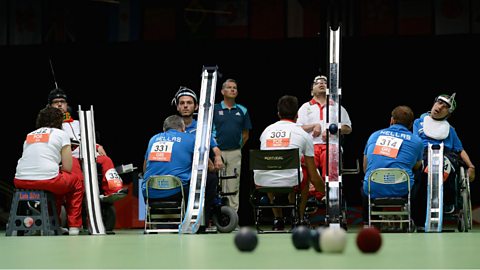Boccia player classifications and playing area
Playing area
- A game of boccia is played on a court measuring 12.5 У 6 m with 2 m of clear space surrounding it.
- The throwing end is split into six throwing boxes that the athletes must stay in during play.
- The V-shaped line is where the target ball must cross for the throw to be valid.
- To play the game, six red balls, six blue balls and a white target ball are required. The specialist balls are covered in leather and contain plastic granules to prevent bouncing but allow rolling.
Players
A competitive game of boccia requires players to be divided into four classifications depending on their disability and functional ability. All players have impaired functional ability in all four limbs.
These classifications are taken from the Great Britain Boccia Federation (GBBF).
- BC1 players with cerebral palsy who are able to use their hands or feet to consistently propel a ball into play. BC1 athletes may have an aide on court to pass them their ball before each shot.
- BC2 - players with cerebral palsy who are able to use their hands to consistently propel a ball into play and have greater functional ability than a BC1 athlete.
- BC3 - players with cerebral palsy or other disability with loco motor dysfunction in all four limbs who are unable to throw or kick a ball into play and as such are permitted to use an assistive device such as a ramp to propel the ball into play and are supported by an assistant ('ramper').
- BC4 - players who do not have cerebral palsy but have another disability with loco motor dysfunction in all four limbs and have similar functional ability to BC2 athletes. Disabilities such as muscular dystrophy and tetraplegia will fall under this classification.
